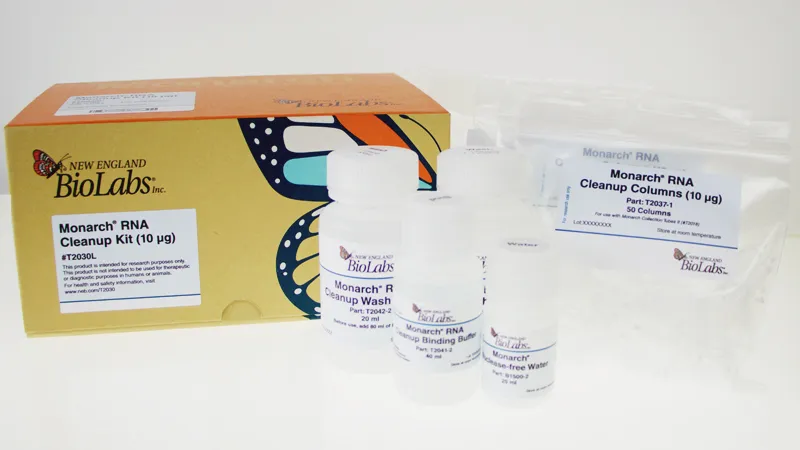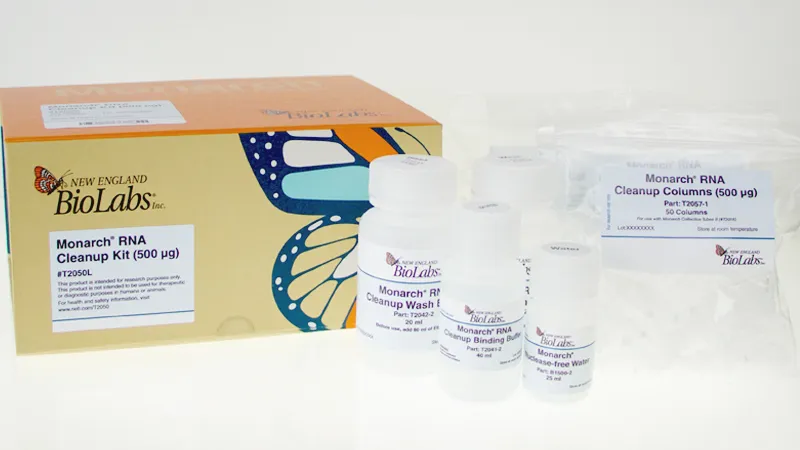mRNA Decapping Enzyme
Product information| Code | Name | Size | Quantity | Price | |
|---|---|---|---|---|---|
M0608S |
mRNA Decapping Enzyme - 2000 units |
2000 units ( 100000 units/ml ) | - | Unavailable in your region |
mRNA Decapping Enzyme
Catalog #M0608
Product Introduction
mRNA Decapping Enzyme decaps m7G-capped mRNA producing a 5′ monophosphate end.
- Efficient replacement for Tobacco Acid Pyrophosphatase
- Cap0 and Cap1 are removed with equal efficiency
- Suitable for 5′ RLM-RACE and RNA-seq
- 1 µl will decap 20 µg of a 1.7 kb mRNA in 15 minutes
- Product Information
- Protocols, Manuals & Usage
- FAQs & Troubleshooting
- Citations & Technical Literature
- Quality, Safety & Legal
- Other Products You May Be Interested In
Product Information
Description
mRNA Decapping Enzyme catalyzes the removal of 7-methylguanosine cap (m7G) from 5´ end of mRNA, producing 5′ monophosphate and releasing m7GDP(1). mRNA Decapping Enzyme is capable of decapping mRNAs of various lengths and removes both Cap0 and Cap1 structures with similar efficiency. mRNA Decapping Enzyme also converts 5′ triphosphate ends to 5′ monophosphate, albeit with reduced efficiency. 5′ monophosphorylated RNA can be exploited in a variety of downstream applications, including 5′ RNA Ligase-mediated RACE, RNA-seq, and 5′-> 3′ exonuclease digestion.
Product Source
mRNA Decapping Enzyme from S.pombe is expressed as a His-tagged fusion in E. coli.- This product is related to the following categories:
- RNA Modification,
Properties & Usage
Unit Definition
One unit is defined as the amount of mRNA Decapping Enzyme required to convert 50% of a 500 nM m7G-capped substrate to a 5´-monophosphorylated form in a total reaction volume of 20 µl in 1 hour at 37˚C.Reaction Conditions
1X mRNA Decapping Enzyme Reaction Buffer
Incubate at 37°C
1X mRNA Decapping Enzyme Reaction Buffer
50 mM Tris-HCl
50 mM Ammonium Chloride
5 mM MgCl2
1 mM DTT
0.1% Poloxamer 188
(pH 7.5 @ 25°C)
Storage Buffer
300 mM NaCl
10 mM Tris-HCl
0.1 mM DTT
50% Glycerol
pH 7.4 @ 25°C
Heat Inactivation
NoRelated Products
Companion Products
References
- Paquette, DR., et. al (2018). RNA. 24 (2), 251-257.
- Grudzien-Nogalska, E., and Kiledjian M (2017). Wiley Interdiscip Rev RNA. 8, e1379.
Protocols, Manuals & Usage
Protocols
FAQs & Troubleshooting
FAQs
- Does mRNA Decapping Enzyme remove 5′ triphosphates?
- Is mRNA Decapping Enzyme activity sensitive to RNA secondary structure?
- Does mRNA Decapping Enzyme have a preference for longer or shorter RNA?
- Is mRNA Decapping Enzyme active in other NEB reaction buffers?
- Does mRNA Decapping Enzyme require the presence of metals for activity?
- Is mRNA Decapping Enzyme active at higher temperatures?
Citations & Technical Literature
Citations
Quality, Safety & Legal
Quality Assurance Statement
Quality Control tests are performed on each new lot of NEB product to meet the specifications designated for it. Specifications and individual lot data from the tests that are performed for this particular product can be found and downloaded on the Product Specification Sheet, Certificate of Analysis, data card or product manual. Further information regarding NEB product quality can be found here.Specifications
The Specification sheet is a document that includes the storage temperature, shelf life and the specifications designated for the product. The following file naming structure is used to name these document files: [Product Number]_[Size]_[Version]Certificate Of Analysis
The Certificate of Analysis (COA) is a signed document that includes the storage temperature, expiration date and quality controls for an individual lot. The following file naming structure is used to name these document files: [Product Number]_[Size]_[Version]_[Lot Number]Safety DataSheets
The following is a list of Safety Data Sheet (SDS) that apply to this product to help you use it safely.mRNA Decapping Enzyme
Legal and Disclaimers
Products and content are covered by one or more patents, trademarks and/or copyrights owned or controlled by New England Biolabs, Inc (NEB). The use of trademark symbols does not necessarily indicate that the name is trademarked in the country where it is being read; it indicates where the content was originally developed. The use of this product may require the buyer to obtain additional third-party intellectual property rights for certain applications. For more information, please email [email protected].This product is intended for research purposes only. This product is not intended to be used for therapeutic or diagnostic purposes in humans or animals.
New England Biolabs (NEB) is committed to practicing ethical science – we believe it is our job as researchers to ask the important questions that when answered will help preserve our quality of life and the world that we live in. However, this research should always be done in safe and ethical manner. Learn more.
Licenses
This product is for in vitro research use only.Other Products You May Be Interested In
The supporting documents available for this product can be downloaded below.







